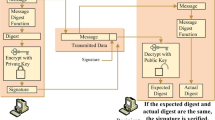Abstract
Restrictive partially blind signature (RPBS) plays an important role in designing secure electronic cash system. Very recently, Wang, Tang and Li proposed a new ID-based restrictive partially blind signature (ID-RPBS) and gave the security proof. In this paper, we present a cryptanalysis of the scheme and show that the signature scheme does not satisfy the property of unforgeability as claimed. More precisely, a user can forge a valid message-signature pair (ID; msg; info′; σ′) instead of the original one (ID; msg; info; σ), where info is the original common agreed information and info′ ≠ info. Therefore, it will be much dangerous if Wang-Tang-Li's ID-RPBS scheme is applied to the off-line electronic cash system. For example, a bank is supposed to issue an electronic coin (or bill) of $100 to a user, while the user can change the denomination of the coin (bill) to any value, say $100 000 000, at his will.
Similar content being viewed by others
References
Chaum D. Blind signatures for untraceable payments. In Proc. Crypto’82, Rivest R L, Sherman A, Chaum D (eds.), New York: Santa Barbara, California, USA, Plenum Press, 1983, pp.199–203.
Brands S. Untraceable off-line cash in wallet with observers. In Proc. Advances in Cryptology (Crypto93), Stinson D R (ed.), Santa Barbara, California, USA, Lecture Notes in Computer Science, Vol. 773, Springer-Verlag, Berlin, Heidelberg, New York, 1993, pp.302–318.
Chan A, Frankel Y, Tsiounis Y. Easy come easy go divisible cash. In Proc. Advances in Cryptology (EUROCRYPT 98), Kaisa Nyberg (ed.), Espoo, Finland, Lecture Notes in Computer Science, Vol. 1403, Springer-Verlag, 1998, pp.561–576.
Boyd C, Foo E, Pavlovski C. Efficient electronic cash using batch signatures. In Proc. Australasian Conference on Information Security and Privacy (ACISP’99), Pieprzyk J, Safavi-Naini R, Seberry J (eds.), Wollongong, NSW, Australia, Lecture Notes in Computer Science, Vol. 1587, Springer-Verlag, 1999, pp.244–257.
Nyang D, Song J. Preventing double-spent coins from revealing user’s whole secret. In Proc. Second International Conference on Information Security and Cryptology (ICISC’99), Song J S (ed.), Seoul, Korea, Lecture Notes in Computer Science, Vol. 1787, Springer-Verlag, 1999, pp.13–20.
Abe M, Fujisaki E. How to date blind signatures. In Proc. Advances in Cryptology (ASIACRYPT’96), Kyongju, South Korea, LNCS 1163, 1996, pp.244–251.
Huang H, Chang C. A new design of efficient partially blind signature scheme. The Journal of Systems and Software, 2003, 73(3): 397–403.
Cao T, Lin D, Xue R. A randomized RSA-based partially blind signature scheme for electronic cash. Computers and Security, 2005, 24(1): 44–49.
Zhang F, Chen X. Cryptanalysis of Huang-Chang partially blind signature scheme. The Journal of Systems and Software, 2005, 76(3): 323–325.
Martinet G, Poupard G, Sola P. Cryptanalysis of a partially blind signature scheme or how to make $100 bills with $1 and $2 ones. In Proc. Financial Cryptography 2006, LNCS 4107, Springer-Verlag, Anguilla, British West Indies, 2006, pp.171–176.
Maitland G, Boyd C. A provably secure restrictive partially blind signature. In Proc. the 5th Int. Workshop on Practice and Theory in Public Key Cryptosystems, Paris, France, LNCS 2274, Springer-Verlag, 2002, pp.99–114.
Abe M, Okamoto T. Provably secure partially blind signatures. In Proc. Advances in Cryptology — Crypto’2000, Santa Barbara, CA, USA, LNCS 1880, Springer-Verlag, 2000, pp.271–286.
Chen X, Zhang F, Mu Y, Susilo W. Efficient provably secure restrictive partially blind signatures from bilinear pairings, Financial Cryptography and Date Security 06, LNCS 4107, Springer-Verlag, 2006, pp.251–265.
Shamir A. Identity-based cryptosystems and signature schemes. In Proc. Advances in Cryptology — CRYPTO’84, Santa Barbara, CA, USA, LNCS 196, Springer-Verlag, 1985, pp.47–53.
Chen X, Zhang F, Liu S. ID-based restrictive partially blind signatures and applications. Journal of System and Software, 2007, 80(2): 164–171.
Wang C, Tang Y, Li Q. ID-based fair off-line electronic cash system with multiple banks. Journal of Computer Science and Technology, 2007, 22(3): 487–493.
Pointcheval D, Stern J. Security arguments for digital signatures and blind signatures. Journal of Cryptology: The Journal of the International Association for Cryptologic Research, 2000, 12(3): 361–396.
Author information
Authors and Affiliations
Corresponding author
Additional information
This work is supported by the National Natural Science Foundation of China under Grant Nos. 60673077, 60503006, 60773202, and 60633030, the National Natural Science Foundation of China-Korea Science and Engineering Foundation Joint Research Project (Grant No. 60611140543) and the National Grand Fundamental Research 973 Program of China (Grant No. 2006CB303104).
Electronic Supplementary Material
Below is the link to the electronic supplementary material.
Rights and permissions
About this article
Cite this article
Liu, SL., Chen, XF. & Zhang, FG. Forgeability of Wang-Tang-Li’s ID-Based Restrictive Partially Blind Signature Scheme. J. Comput. Sci. Technol. 23, 265–269 (2008). https://doi.org/10.1007/s11390-008-9128-9
Received:
Revised:
Published:
Issue Date:
DOI: https://doi.org/10.1007/s11390-008-9128-9




